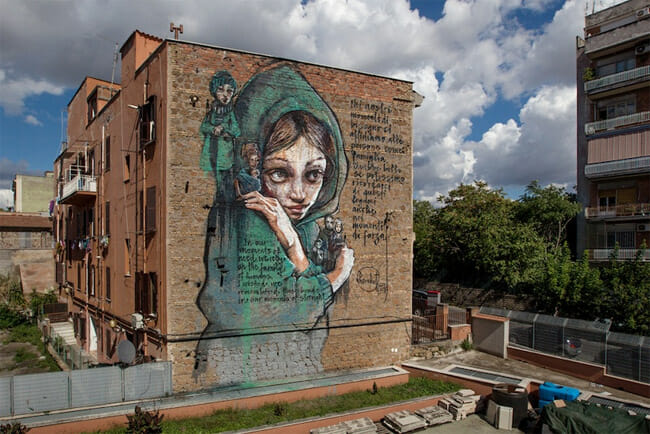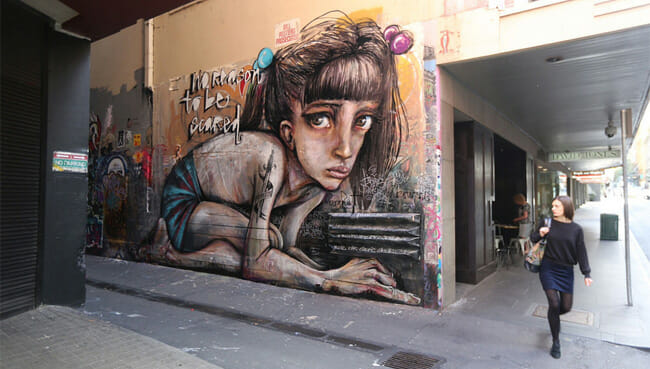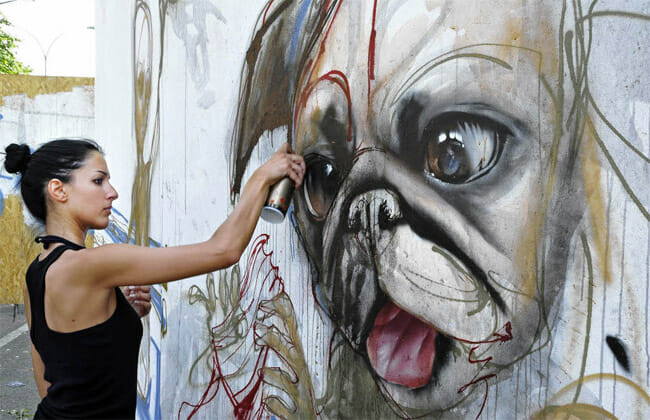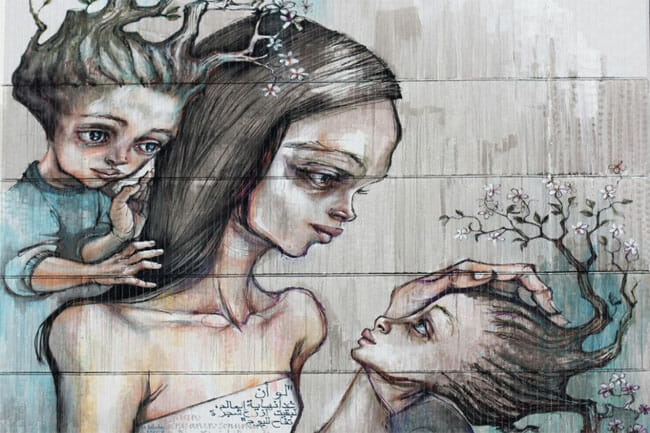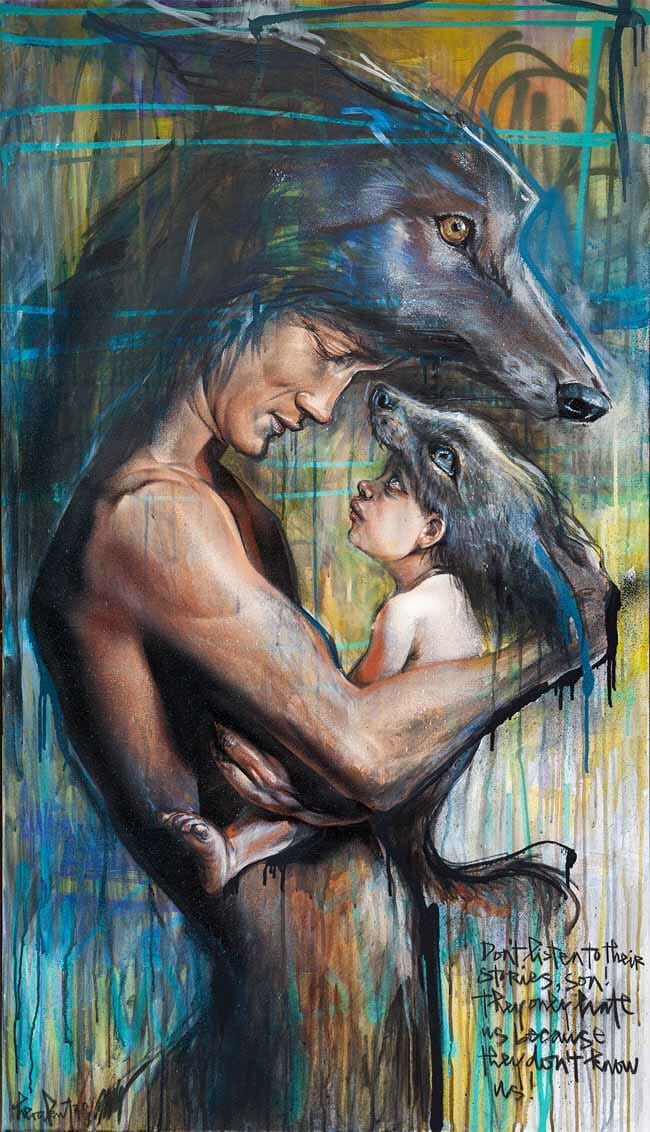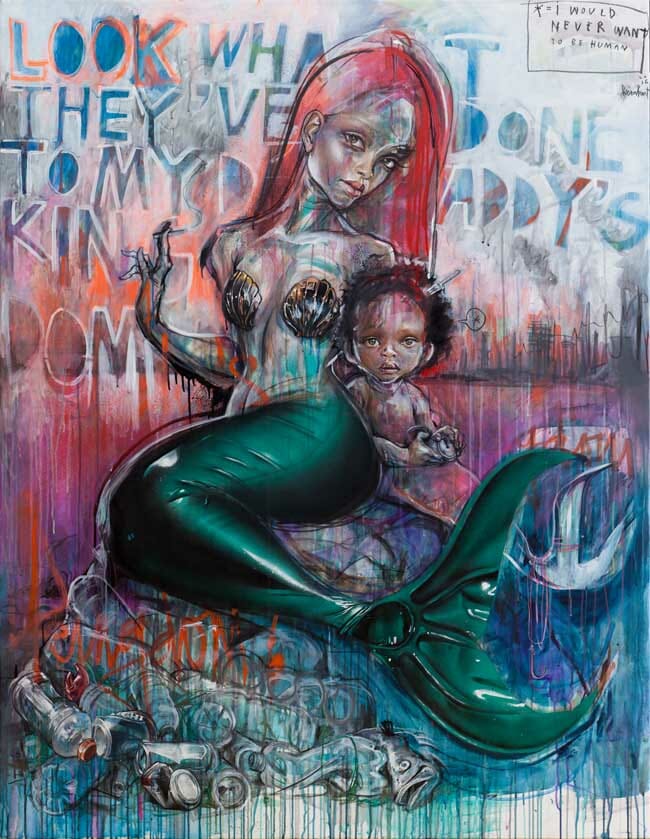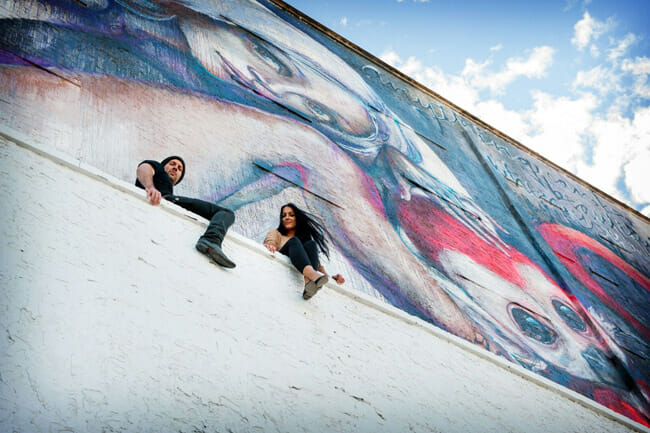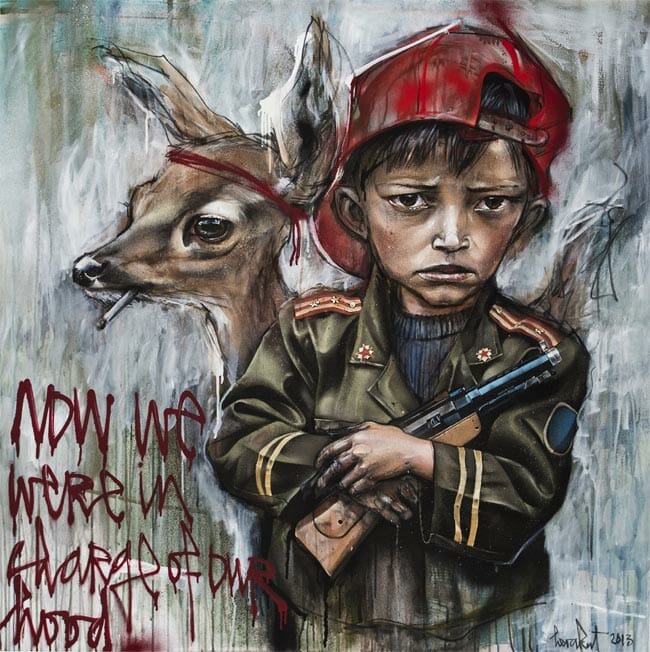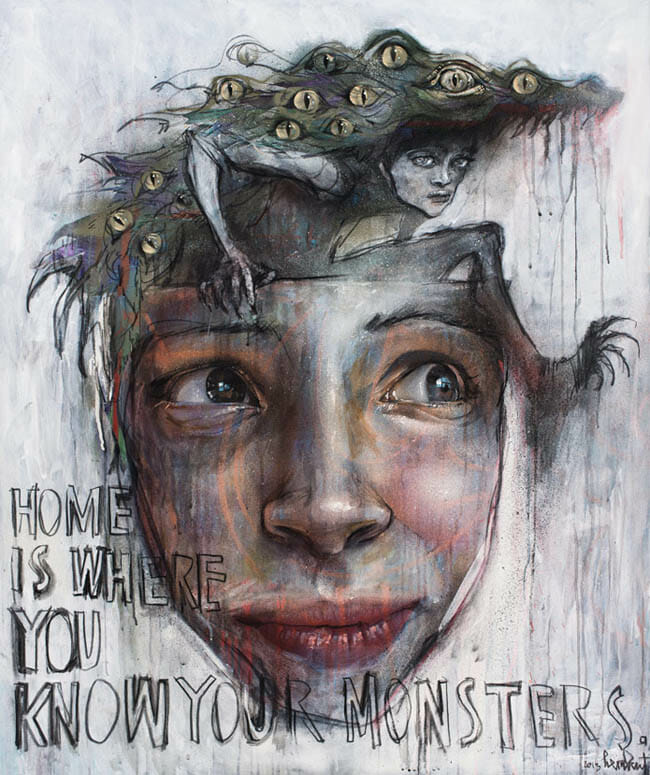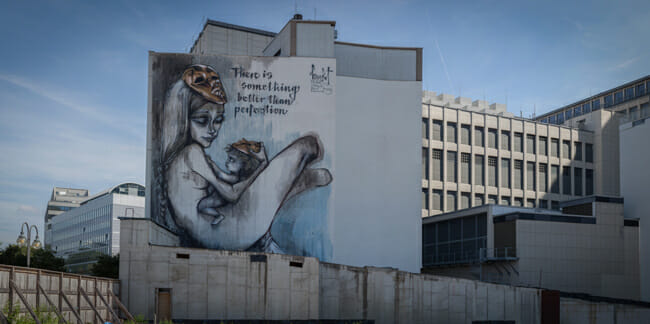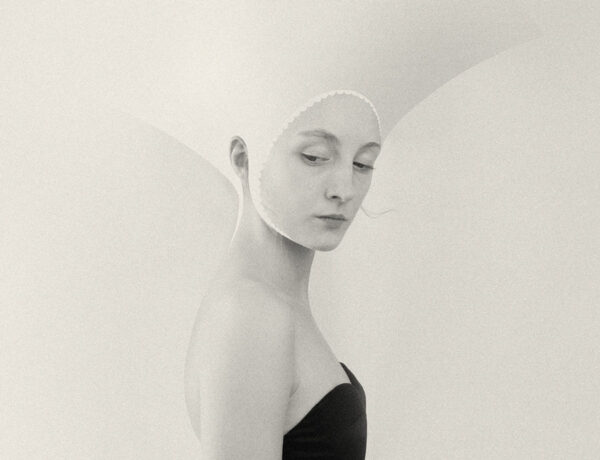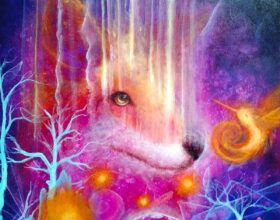The evocative and oft melancholy expressions of children gaze at us, naked or half-clothed figures poignantly rendered, dance, embrace, play and cavort in loosely painted strokes and drips, words and messages are scrawled in a spider like hand… these form the imagery of Herakut. You cannot help but be mesmerized by the layering of their paintings and the balance of the loose painterly stroke with a skillful rendering of realistic elements.
Their powerful expressions of creativity can be appreciated in the form of a canvas within the intimate space of a gallery wall, to a vast mural on a building wall, monumental and breathtaking in its overwhelming size and scale. Herakut is the creative partnership of two exceptional German artists, Jasmin Siddiqui and Falk Lehma. Hera the painter and Akut the graffiti artist have merged their individual approaches in a unique blend of the painterly and street art. Their mostly commissioned artworks can be found in cities around the world – from Toronto to Kathmandu, from San Francisco to Melbourne.
Interview conducted in conjunction with Herakut’s editorial in Issue 020 of Beautiful Bizarre Magazine. We hope you enjoy!
You met in 2004, and began an artistic partnership after that, which I have heard you refer to in an interview as being Yin and Yang in nature, which implies that you mesh together naturally to form a whole. This seems an accurate description as I watched you paint a mural on a transparent surface to record your process and it was as if you think and paint as one. Jasmin, you have said that you ‘do the groundwork’, or ‘build the skeleton’ and Falk ‘adds the flesh and the skin, and whatever he thinks is important to give it an interesting touch.’ Watching you paint, this happens almost simultaneously. Could you tell us a little more about your current process in detail?
JASMIN: We have always had an equal respect for the other one´s work, which in fact paved the way to this trusting artistic relationship. Without asking the other one, we take claim, dive in and take claim. Our technical skills, our little tricks, have grown since we first met in 2004, but the respect and admiration we have for one another has not changed a bit.
FALK: The content of our work, we do discuss. Being male and female, one from the countryside in East Germany, the other from a big city in West Germany, we do bring our differences to the table, but agree quite easily on the direction we are going, as we also share the same kind of respect for our audience, indoors and outdoors. This audience response has a huge impact on our mural work.
JASMIN: The worst thing was, when an elementary school teacher said, her students hated the mural they had to pass by every morning, as it depicted a skeleton, which they, supposedly were afraid of. No matter how ridiculous this might seem to any true artist, but we did feel responsible for those kids who felt bothered by our painting. Making anyone feel uncomfortable is definitely not our goal.
Viewers of your artworks can see that you have brought your individual styles together in a highly successful fusion of energy, raw mark making and realistic figurative elements. What do each of you bring to the partnership in terms of visual qualities and how do these differ from each other? Could each of you explain what qualities you admire in the other’s mark making and artwork?
FALK: As part of the graffiti crew Ma´Claim I had already established my photorealistic style and had painted all over the world before I met Jasmin/Hera and that punk-rock attitude she carried along. In the graffiti world, “drips” were unheard of in 2003/2004 and this girl based her whole style on drips.
JASMIN: The earth tones and drips came naturally, as I had no money to spend on buying paint; therefore I collected all those half-empty paint buckets on constructions sites and stretched them with lots of water. Poverty feeds creativity. But the graffiti cracks did not appreciate me – well, for the first 10 years they did not.
FALK: Jasmin´s to some extent “organized” messiness is the perfect contrast to the accuracy I bring to the work. She has a feel for proportions without any photo reference at all. This allows us to do some kind of “shift work”, where Jasmin will go first and sketch her idea roughly onto a wall or canvas, before the two of us take our time to discuss the direction the piece will head towards content-wise. Once we are settled on an idea, and Jasmin might have adjusted a few bits, I organize a professionally lit photo shoot, so I have the best possible reference images to work from when I basically fill in Hera´s first lines.
You both work on murals all over the world together, and on canvases for gallery exhibition, but I know Jasmin exhibits in her own right and I’m assuming Falk that you maintain an individual artistic practice as well. What percentage of your time is spent as Herakut, and as individual artists? How do you maintain and focus on your individual artistic practices and careers? How important is it for you to maintain those away from Herakut? Has the work of Herakut ever threatened to swallow you as individual artists or has it benefited your individual profiles?
FALK: Jasmin has always done her drawings and put together her sculptures and costumes. She cannot sit still, and she dreams of our creatures coming to life at some point, as well. Let it be animation or real performance art. It is something she has produced in various ways ever since we met.
JASMIN: Thankfully Falk continuously develops his style a photographer, all the while being a great photo realist painter. In 2015, we traveled to Gaza along with our amazing activist friend Samantha Robison, founder of aptART (Awareness and Prevention Through Art). Within a week, he painted eight beautiful murals with local artists and Palestinian neighborhood kids. The output was so beautiful! I guess, our own separate projects fuel our competitive spirits just the right way. After I worked with refugee children at a displaced people housing facility in Potsdam, Germany in 2017, Falk quickly decided he wanted to join in on the same thing next year. That is great to know. If one of us does a project of their own, he or she will not stay lonely for long!
Being an artist requires a certain amount of ego. To work as a successful partnership, you have to suppress ego. You must ‘stop talking’ and ‘listen’ to each other in a visual sense. To make public artwork, that may or may not be lasting, requires letting go of the ‘ego’ of the ‘precious art object’ in order to create something that benefits many, rather than a few. Genuine street art does not aim at ownership, but at capturing and sharing a concept. This is very different to works made for gallery exhibition and sale, which are the epitome of the commodification of artwork. Would you agree with this? Do you feel there must be a letting go of ego in order to work together effectively to create public works?
FALK: Artistically we both grew up in the graffiti world in which working in teams is standard practice. Ego is fine to have, but needs to be paired with respect for the other one´s ego. There is a very practical side to it. Four hands can create faster than just two, and traveling is more fun together. My time as a member of Ma´Claim crew before we started Herakut, took me and my three crew buddies all over the globe to paint. There is something about having each others backs and being able to share the good and the bad, that the usual lonesome studio artist is clearly missing out on.
JASMIN: What happens when you paint together, whether it is on canvas or wall, you create moments that you own and take home. Falk and I share so many memories of absurd incidents, people we met while painting, etc. Being able to share these moments is really actually more important than keeping the piece of work. We own those memories, while the public gets to own the artwork, which feels to us like we have a good deal. There is no hardship in letting a piece go, either as a mural or a canvas sold in a gallery setting. Our reason to paint is communication. In order to start a conversation you have to put something out there first. Being able to do this as a duo is really a gift, as we can discuss what it is we want to leave with people, debate it first, form a thesis we can both agree on, and then we have thought it out thoroughly. This way our work, especially the writing, is more thought through, as logically two brains have been involved in the process. The next step is to watch the public or gallery crowds react to those thoughts. Watching responses to murals is always the most exciting part, when a bus driver halts his bus, sticks his head out of the window and yells something like “looks much nicer now!” Those moments are the kind of ‘trade’ we do: we give art and receive beautiful little interactions with strangers.
Herakuts’ approach has been described as humanitarian. “The goal has always been to beautify the darker places of a city and plant positive signs of life and thought.” So essentially, you would like to make the world a better place through your storytelling, your narrative style and by bringing beauty to the public. This reminds me of how the early churches used artwork to ‘talk’ to Christian. In a way, your artwork serves this purpose as you use your art to communicate and be a positive influence in society. More than half of your work is dedicated to charity causes. Firstly, could you describe how those stories are generated? What issues you have focused attention on most effectively over the years? What do you see as the impact of your art in influencing the public?
JASMIN: Before we decide on what to paint in certain parts of the world, researching that place´s history is just as important to us as getting locals to speak about their city. What the community needs, is more interesting to us than what we want to say. In general, I am the one asking tons of questions, trying to get a feel for the neighborhood. My goal is to give people some food for thought, an idea to chew on. So, I actually articulate these ideas in whatever language is spoken in that place of the globe, and write it out onto the wall, like a piece of a poem. It is not an explanation or subtext to the figurative part of the piece, but instead an addition that brings a seriousness to our children’s book like characters. Those characters are fragile, sometimes childlike, but the words in the messages add depth.
FALK: The symbols we use are rather archaic, as all early cultures used animals and their traits to describe certain human characteristics. To understand what each animal stands for seems come to people so naturally, that this sort of symbolism has become a valuable tool for our storytelling. Of course, not all symbols work universally, e.g. in those parts of the world where dogs are frowned upon and seen as filthy pest, painting a dog to personify loyalty and companionship does not go down well. Cultural sensitivity and research have helped us avoid problems so far.
JASMIN: You could say that Herakut is propagating the use of imagination. We are campaigning for dreaminess, a new layer to our reality in which invisible friends do exists, little fairies stroke our backs and where everyone is stripped down to their bare selves. As an artist you are already trained in seeing things appear out of nothing, you basically use paint those make the imaginative lines visible to others. But everyone has the ability. We wished more people dared to dream and create. It is so satisfying. Just look at the face of a child who just finished a painting project or created a sand sculpture: it is an expression of satisfaction and pride. The kid is proud of what his hands can do, and we believe our future must be placed into hands that create – not destroy.
In researching this interview, I read that Street Art, mural art, can be “…the opening of a communal space: a commentary, a conversation, a concept captured in an image on a wall. Genuine street art aims at this ideal. If art is capable of anything in this world, it is cutting through the dross of everyday existence. Art holds up a mirror to the world so that we can see the absurdity of it. It shows us who we really are, both good and bad, as a community. Street art has an amazing ability to do this because it exists in our real and everyday world, not vacuum-sealed and shuffled away in a privileged private space. It’s very public nature makes street art unique, powerful, and amazing.”
I wondered, if because a mural might become so much a part of our daily life, does it become, something we don’t register or do they become so much a part of our unconsciousness as to become almost a collective consciousness and therein lies their power?
FALK: Here is one recent example for how affectionate people can be with art: For four years we had a big mural in Frankfurt, Germany, that showed a mother and a child with golden masks pushed out of their faces (title: “There is something better than perfection”). The construction work of a building made our wall disappear slowly with each floor of the newly built house. All through this process, there were photos and photos of people who passed by, of neighbors, of a Frankfurt newspaper, even, along with messages that “mourned” the loss of this artwork. It was the sweetest thing. Beautiful to know, that people might take murals for granted at some point, but can truly be saddened if its sight vanishes from their everyday life.
Herakut’s Social Media Accounts
Website | Instagram | Facebook


